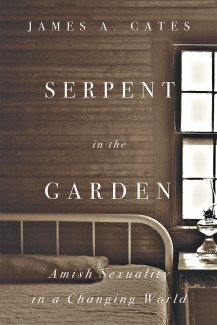
Johns Hopkins UniversityEst. 1876
America’s First Research University
Now Browsing:
Serpent in the Garden: Amish Sexuality in a Changing World

Writing about another culture is never easy. Writing about sexuality and another culture? That takes a bold pen. Serpent in the Garden was not an easy book to write for that reason. In the end, though, those who have read it agree. It delivers a perspective that has been lacking on this aspect of Amish life.
Serving the Amish, my first book on this Plain people, was published in 2014. It included a chapter on sexuality, and a friend suggested that I could amplify those comments and offer another, much-needed book. The first challenge was a framework. Amish sexuality was embedded in their culture, and many talented authors had already offered models to describe the social glue that held them together. I needed a different perspective. Something that would upend the reader familiar with the Amish. Something that would acknowledge Amish sexuality as culturally unique, but also universal.
The Amish were not always a postmodern paradox. Once upon a time they separated from their neighbors, but prior to the telephone, the motor vehicle, and electricity from the grid, prior to the urbanization of North America, they were a rural anomaly, but hardly as distant as they have become in the twenty-first century. As a distinct entity, they are walled off from the sexual mores of the times. We cohabitate; they do not. We recognize gay marriage; they do not. We are tolerant of casual sexual encounters; they are not. We accept divorce as a solution to irreconcilable relationships; they do not. With our loosened moral standards (compared to mid-twentieth century America), we are the heteronormative; they are not.
And standing their moral ground as they do, distinct and separate from the majority, the Amish have become a peculiar minority. They balk at heteronormative expectations. And in doing so, they fit perfectly into a model that was created for their moral opposite, the queer community. Queer theory is tailor-made for their beliefs.

Queer theory is amorphous, flexible, and wide-ranging. It is applied in psychology, sociology, anthropology, and literature. But its elegance is in its transparency. In the words of Mark Graham, the anthropologist, “At its simplest, queer theory is a critical inquiry into the alignments of sex, gender and desire that are in the service of normative forms of heterosexuality, the heteronormative, that saturates the social and cultural order.” To apply this model to Amish beliefs, held in the face of a rapidly transitioning worldview, lends an understanding to their concepts of sex, sexuality, gender roles, and intimacy.
The use of queer theory does not simplify Amish sexuality. Neither cultural sexuality nor individual sexuality is simple. The complex interplay of hard-wired, physiological sexual drive, developmental experiences, cultural expectations, and interpersonal environment within that culture make sexuality a daunting topic for the most intrepid writer. But it does offer an understanding of how the Amish circle the wagons (or in this case, buggies) against the encroaching beliefs of the larger world. Their logic and purpose behind an emphasis on sex as God’s gift to a married couple, with a primary purpose of procreation. Their sorrow and even fear when that gift is squandered as a hedonistic act.
And within that tight circle, the experience of sexual behavior knows the full range of acting out. The Amish can keep the loosened moral standards of the world at bay, but they cannot distance their own urges and desires. They are compelled to deal with the sexual acting out of child abuse, fetishes, and same-sex desires. They do so in ways that we recognize, at times as painful and ineffective, and at other times as efforts to rise to noble heights of forgiveness. They are ultimately human in the universal struggle to curb the negative consequences of sexual behavior. They may differ in behaviors they consider acting out, and they may differ in their consequences, but they struggle, as we all do, with how best to tame our sexual desires.
Queer theory and the Amish. Not an intuitive match, but a match that fit like a hand in a glove, once it was underway. And in response to the question I am often asked: “What will the Amish think of this book?” I like to respond with the comment of an Amish friend. “This is a book,” he said, “That will be read under the covers, by flashlight.” I hope he is right.
Order Serpent in the Garden: Amish Sexuality in a Changing World – published on September 1, 2020 – at the following link: https://jhupbooks.press.jhu.edu/title/serpent-garden
James A. Cates is a clinical psychologist in private practice in northeastern Indiana. He is the author of Serpent in the Garden: Amish Sexuality in a Changing World and Serving the Amish: A Cultural Guide for Professionals.

Serving the Amish, my first book on this Plain people, was published in 2014. It included a chapter on sexuality, and a friend suggested that I could amplify those comments and offer another, much-needed book. The first challenge was a framework. Amish sexuality was embedded in their culture, and many talented authors had already offered models to describe the social glue that held them together. I needed a different perspective. Something that would upend the reader familiar with the Amish. Something that would acknowledge Amish sexuality as culturally unique, but also universal.
The Amish were not always a postmodern paradox. Once upon a time they separated from their neighbors, but prior to the telephone, the motor vehicle, and electricity from the grid, prior to the urbanization of North America, they were a rural anomaly, but hardly as distant as they have become in the twenty-first century. As a distinct entity, they are walled off from the sexual mores of the times. We cohabitate; they do not. We recognize gay marriage; they do not. We are tolerant of casual sexual encounters; they are not. We accept divorce as a solution to irreconcilable relationships; they do not. With our loosened moral standards (compared to mid-twentieth century America), we are the heteronormative; they are not.
And standing their moral ground as they do, distinct and separate from the majority, the Amish have become a peculiar minority. They balk at heteronormative expectations. And in doing so, they fit perfectly into a model that was created for their moral opposite, the queer community. Queer theory is tailor-made for their beliefs.

Queer theory is amorphous, flexible, and wide-ranging. It is applied in psychology, sociology, anthropology, and literature. But its elegance is in its transparency. In the words of Mark Graham, the anthropologist, “At its simplest, queer theory is a critical inquiry into the alignments of sex, gender and desire that are in the service of normative forms of heterosexuality, the heteronormative, that saturates the social and cultural order.” To apply this model to Amish beliefs, held in the face of a rapidly transitioning worldview, lends an understanding to their concepts of sex, sexuality, gender roles, and intimacy.
The use of queer theory does not simplify Amish sexuality. Neither cultural sexuality nor individual sexuality is simple. The complex interplay of hard-wired, physiological sexual drive, developmental experiences, cultural expectations, and interpersonal environment within that culture make sexuality a daunting topic for the most intrepid writer. But it does offer an understanding of how the Amish circle the wagons (or in this case, buggies) against the encroaching beliefs of the larger world. Their logic and purpose behind an emphasis on sex as God’s gift to a married couple, with a primary purpose of procreation. Their sorrow and even fear when that gift is squandered as a hedonistic act.
And within that tight circle, the experience of sexual behavior knows the full range of acting out. The Amish can keep the loosened moral standards of the world at bay, but they cannot distance their own urges and desires. They are compelled to deal with the sexual acting out of child abuse, fetishes, and same-sex desires. They do so in ways that we recognize, at times as painful and ineffective, and at other times as efforts to rise to noble heights of forgiveness. They are ultimately human in the universal struggle to curb the negative consequences of sexual behavior. They may differ in behaviors they consider acting out, and they may differ in their consequences, but they struggle, as we all do, with how best to tame our sexual desires.
Queer theory and the Amish. Not an intuitive match, but a match that fit like a hand in a glove, once it was underway. And in response to the question I am often asked: “What will the Amish think of this book?” I like to respond with the comment of an Amish friend. “This is a book,” he said, “That will be read under the covers, by flashlight.” I hope he is right.
Order Serpent in the Garden: Amish Sexuality in a Changing World – published on September 1, 2020 – at the following link: https://jhupbooks.press.jhu.edu/title/serpent-garden
James A. Cates is a clinical psychologist in private practice in northeastern Indiana. He is the author of Serpent in the Garden: Amish Sexuality in a Changing World and Serving the Amish: A Cultural Guide for Professionals.

Login to View & Leave Comments
Login to View & Leave Comments


